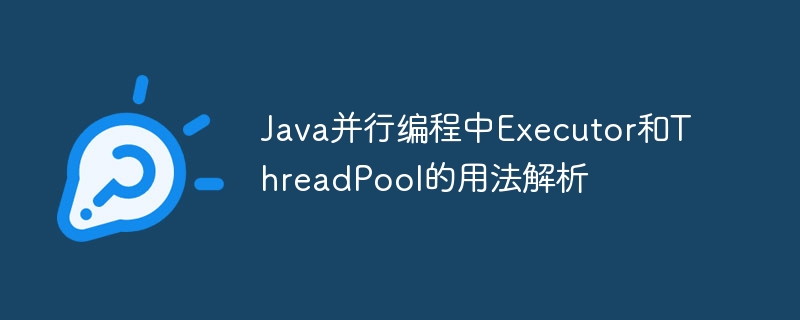Executor介面提供任務執行機制,而ThreadPool是其實現,管理執行緒池來執行任務。 ThreadPool使用Executors工具類別創建,如newFixedThreadPool(),並使用execute()方法提交任務。在實戰案例中,使用ExecutorService和ThreadPool計算數位平方和,以展示平行程式設計的使用方式。注意事項包括平衡執行緒池大小和任務數量,避免異常拋出,並在使用後關閉ThreadPool。

Java並行程式設計中的Executor和ThreadPool使用指南
在Java中實作並行程式設計時,Executor和ThreadPool是兩大核心概念。在本教程中,我們將深入探討這兩種機制,並透過實戰案例示範如何使用它們。
Executor
Executor介面代表一個任務執行機制。它提供了一個通用的方法execute(),用於提交任務執行。透過實作Executor接口,可以自訂任務的執行方式,例如,建立自訂的執行緒池或使用現成的執行緒池。
public class CustomExecutor implements Executor {
@Override
public void execute(Runnable command) {
// 自定义任务执行逻辑
// ...
}
}ThreadPool
ThreadPool是Executor的一個實現,提供了一組執行緒來並行執行任務。它管理執行緒的生命週期,確保同時執行的任務數量不會超過執行緒池大小。
可以使用Executors工具類別建立執行緒池,例如newFixedThreadPool()和newCachedThreadPool():
ExecutorService threadPool = Executors.newFixedThreadPool(5);
threadPool.execute(new Runnable() {
@Override
public void run() {
// 任务代码
}
});實戰案例
計算數字平方
考慮一個並行計算數字平方和的場景。我們可以使用Executor和ThreadPool實作如下:
import java.util.Arrays;
import java.util.concurrent.ExecutorService;
import java.util.concurrent.Executors;
public class SquareSum {
private static int[] numbers = new int[] { 1, 2, 3, 4, 5, 6, 7, 8, 9, 10 };
public static void main(String[] args) {
ExecutorService threadPool = Executors.newFixedThreadPool(Runtime.getRuntime().availableProcessors());
long sum = 0;
for (int number : numbers) {
threadPool.execute(() -> sum += Math.pow(number, 2));
}
threadPool.shutdown();
while (!threadPool.isTerminated()) {
try {
Thread.sleep(10);
} catch (InterruptedException e) {
e.printStackTrace();
}
}
System.out.println("Square sum: " + sum);
}
}在這個案例中,Executors.newFixedThreadPool()建立了一個執行緒池,其大小與可用處理器的數量相符。然後,任務被提交到線程池,並行計算每個數字的平方。最後,shutdown()方法關閉了執行緒池,並等待所有任務完成。
注意事項
ThreadPool時,應注意執行緒池大小和任務數量的平衡。執行緒池過大可能導致資源浪費,而執行緒池過小可能導致效能瓶頸。 Executor的任務不應拋出例外。如果一個任務拋出異常,Executor可能會失敗,導致所有其他任務無法執行。 ThreadPool後,應使用shutdown()方法關閉執行緒池,以確保所有執行緒都已停止。 以上是Java並行程式設計中Executor和ThreadPool的用法解析的詳細內容。更多資訊請關注PHP中文網其他相關文章!
